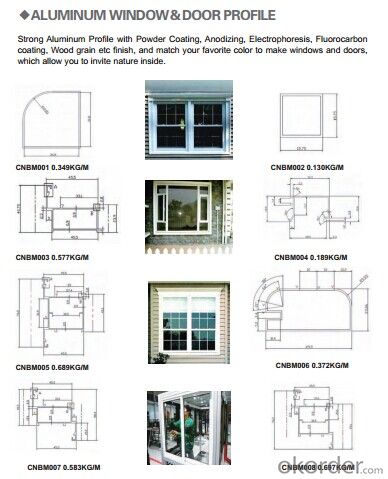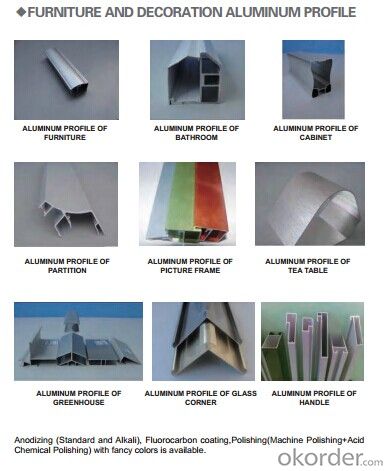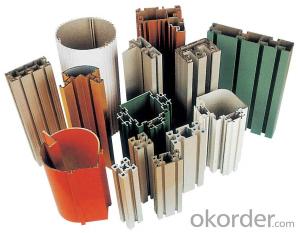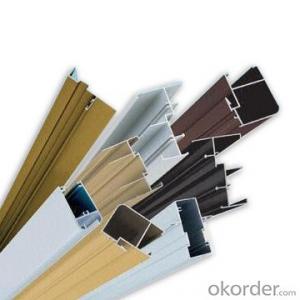Alu profile extrusion 6061 T5
- Loading Port:
- China Main Port
- Payment Terms:
- TT OR LC
- Min Order Qty:
- -
- Supply Capability:
- -
OKorder Service Pledge
OKorder Financial Service
You Might Also Like
Aluminium is a relatively soft, durable, lightweight, ductileand malleablemetalwith appearance ranging from silvery to dull gray, depending on the surfaceroughness. It is nonmagnetic and does not easily ignite. A fresh film ofaluminium serves as a good reflector (approximately 92%) of visible lightand an excellent reflector (as much as 98%) of medium and far infraredradiation. The yield strength of pure aluminium is 7–11 MPa,while aluminium alloys have yield strengths ranging from200 MPa to 600 MPa. Aluminium has about one-third the densityand stiffness of steel. It is easily machined,cast, drawn and extruded.
Aluminium alloys (or aluminum alloys; see spellingdifferences) are alloysin which aluminium(Al) is the predominant metal. The typical alloying elements are copper, magnesium,manganese,silicon,tin and zinc. There are twoprincipal classifications, namely casting alloys and wrought alloys, both of which are furthersubdivided into the categories heat-treatableand non-heat-treatable. About 85% of aluminium is used for wrought products,for example rolled plate, foils and extrusions.Cast aluminium alloys yield cost-effective products due to the low meltingpoint, although they generally have lower tensile strengthsthan wrought alloys. The most important cast aluminium alloy system is Al–Si,where the high levels of silicon (4.0–13%) contribute to give good castingcharacteristics. Aluminium alloys are widely used in engineering structures andcomponents where light weight or corrosion resistance is required
Features:
Material | Alloy 6063,6061,6005or according to customer’s choice |
Temper | T3, T4, T5, T6 |
Surface | Anodize, electrophoresis, powder coating, PVDF coating, wood grain painting, matted, etc. |
Length | Coating 6.5 meters, Anodizing 6.5 meters, Mill finish 5 meters |
Application | Industrial, electrical equipment(TV set, air conditioner, refrigerator, computer), decoration,construction, transportation |
Custom Made | We can package following with customer's request. |




FAQ:
1. What is the form of payment?
Normally 30% TT, L/C at sight
2. Type of quotation?
FOB, CFR, CIF
3. Port of loading?
Shenzhen/Guangzhou port
4. Delivery time?
15-20 days after client’s deposit
- Q:What are the aluminum profile markets in Cangzhou, Renqiu?
- They all answered, "I tell you, ah, play, huh?"Choose me as the best, hey!
- Q:How do aluminum profiles contribute to sustainable building practices?
- Aluminum profiles play a crucial role in promoting sustainable building practices for several reasons. Firstly, aluminum is a highly recyclable material, meaning that it can be melted down and reused multiple times without any loss in quality. This recyclability greatly reduces the need for extracting and processing virgin aluminum, which is an energy-intensive and environmentally damaging process. By using aluminum profiles in construction, we can significantly minimize the demand for new aluminum production, thus conserving natural resources and reducing carbon emissions. Moreover, aluminum profiles are lightweight yet strong, making them ideal for creating energy-efficient structures. The lightweight nature of aluminum reduces the load on the building's foundation and structural elements, resulting in lower material requirements and reduced construction costs. Additionally, a lighter structure requires less energy to heat and cool, leading to decreased energy consumption and reduced greenhouse gas emissions over the building's lifespan. Furthermore, aluminum profiles have excellent thermal and acoustic insulation properties. When properly utilized, they can contribute to the overall energy efficiency of a building by minimizing heat loss or gain through windows and doors. This translates into reduced reliance on artificial heating and cooling systems, leading to decreased energy consumption and lower utility bills. Additionally, aluminum profiles are highly durable and require minimal maintenance. Their resistance to corrosion, weathering, and UV rays ensures a long lifespan, reducing the need for frequent replacements and repairs. This not only saves resources but also reduces waste generation and landfill usage. Lastly, aluminum profiles offer great design flexibility and can be easily integrated into various architectural styles and designs. This versatility enables architects and builders to create aesthetically pleasing and functional structures that meet the needs of occupants while still adhering to sustainable building practices. In conclusion, aluminum profiles contribute to sustainable building practices by being recyclable, lightweight, energy-efficient, thermally insulating, durable, low maintenance, and versatile. By incorporating aluminum profiles into construction projects, we can reduce our environmental footprint, conserve natural resources, and promote a more sustainable future.
- Q:What are the different cross-sectional shapes available for aluminum profiles?
- There are several different cross-sectional shapes available for aluminum profiles, including square, rectangular, round, T-shaped, and I-shaped.
- Q:Can aluminum profiles be used in railway and transportation infrastructure?
- Yes, aluminum profiles can be used in railway and transportation infrastructure. Aluminum is a lightweight and durable material that offers several advantages in these applications. One of the main benefits of using aluminum profiles in railway and transportation infrastructure is their low weight. Aluminum is significantly lighter than other materials like steel, making it easier to transport and install. This weight reduction can also lead to energy savings, as less fuel is required to move the infrastructure elements. Additionally, aluminum profiles have a high strength-to-weight ratio, meaning they can withstand heavy loads while still being relatively lightweight. This makes them suitable for various structural applications, such as supporting overhead power lines, constructing platforms, and forming the framework for bridges and tunnels. Aluminum also has excellent corrosion resistance, which is crucial in railway and transportation infrastructure exposed to harsh weather conditions and environmental elements. Aluminum profiles can withstand moisture, UV rays, and other corrosive agents, reducing maintenance requirements and increasing the lifespan of the infrastructure. Moreover, aluminum profiles can be easily fabricated and customized to meet specific design requirements. They can be extruded into various shapes and sizes, allowing for flexibility in design and construction. Aluminum profiles can also be easily joined together using different methods, such as welding or fastening, providing ease of assembly and disassembly if needed. In conclusion, aluminum profiles can indeed be used in railway and transportation infrastructure. Their lightweight, high strength, corrosion resistance, and versatility make them an excellent choice for various structural and functional applications in these sectors.
- Q:What is the thickness of the aluminum alloy window frame?
- According to the GB / T5237 Aluminum Alloy "building materials" regulations, construction aluminum minimum nominal wall thickness should be not less than 1.2mm, wherein the solid profile wall thickness error of 0.15mm, namely the wall thickness not less than 1.05mm; hollow profile parts containing a closed cavity wall thickness allowance of 0.23mm, the wall thickness is not lower than 0.97mm.
- Q:Are aluminum profiles compatible with glass?
- Glass is compatible with aluminum profiles. In different applications like windows, doors, curtain walls, and partitions, aluminum frames are often used as framing systems for glass panels. This compatibility is due to aluminum's lightweight, durability, and resistance to corrosion, which make it an excellent material for holding and supporting glass panels. By using different profile designs, aluminum frames can securely hold glass of various types and thicknesses, giving structural stability and enhancing the overall appearance. Furthermore, aluminum profiles can be customized and engineered to meet specific glass installation needs, ensuring a perfect fit and compatibility between the two materials.
- Q:Changhe brand aluminum can?
- Profile is not bad, but visibility is not too large, the whole is still very good, cost-effective
- Q:What are the durability characteristics of aluminum profiles?
- Aluminum profiles are known for their excellent durability characteristics. They have a high strength-to-weight ratio, allowing them to withstand heavy loads without deforming or breaking. Additionally, aluminum is highly resistant to corrosion, making it suitable for both indoor and outdoor applications. The material is also non-combustible, providing added safety in case of fire. Overall, aluminum profiles offer long-lasting performance and are an ideal choice for various structural and architectural purposes.
- Q:Are aluminum profiles suitable for use in the electronics industry?
- Yes, aluminum profiles are suitable for use in the electronics industry. Aluminum is lightweight, corrosion-resistant, and has excellent thermal conductivity, making it ideal for applications such as heat sinks, enclosures, and frames in electronic devices. Additionally, aluminum profiles can be easily customized and are cost-effective, making them a popular choice in the electronics industry.
- Q:Are aluminum profiles resistant to impact?
- Aluminum profiles are typically able to withstand impact, making them a reliable choice. Aluminum is renowned for its impressive strength-to-weight ratio, which means it is both robust and lightweight. This feature makes it ideal for situations where impact resistance is crucial, like in construction where it is utilized for window frames, doors, and curtain walls. Moreover, aluminum profiles can be strengthened further by applying different surface treatments and coatings to enhance their impact resistance. Nevertheless, it is important to acknowledge that the impact resistance of an aluminum profile may differ based on factors such as thickness, design, and any supplementary reinforcements employed.
1. Manufacturer Overview |
|
|---|---|
| Location | |
| Year Established | |
| Annual Output Value | |
| Main Markets | |
| Company Certifications | |
2. Manufacturer Certificates |
|
|---|---|
| a) Certification Name | |
| Range | |
| Reference | |
| Validity Period | |
3. Manufacturer Capability |
|
|---|---|
| a)Trade Capacity | |
| Nearest Port | |
| Export Percentage | |
| No.of Employees in Trade Department | |
| Language Spoken: | |
| b)Factory Information | |
| Factory Size: | |
| No. of Production Lines | |
| Contract Manufacturing | |
| Product Price Range | |
Send your message to us
Alu profile extrusion 6061 T5
- Loading Port:
- China Main Port
- Payment Terms:
- TT OR LC
- Min Order Qty:
- -
- Supply Capability:
- -
OKorder Service Pledge
OKorder Financial Service
Similar products
New products
Hot products
Hot Searches
Related keywords






























